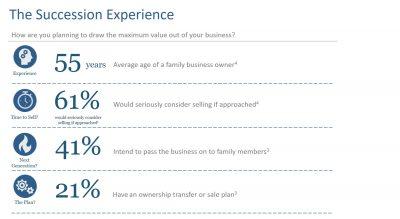
Family business succession planning 101
15.2.2018A few years ago, our newsletter explored the succession planning paradox. That is, many businesses don’t have a clear succession plan in place, despite this being essential for value preservation and risk management. A number of studies on the topic have been published since this time, and overall it seems that not much has changed. There has been a slow march towards adoption, however there is still a way to go.
Of course, every business owner would agree that planning for the future is paramount, however the day-to-day operations have a knack of screaming for attention. The time spent planning for the future may be the most important and profitable hours one can take. Despite this, it remains difficult for businesses owners to plan for succession, whether through sale or passing on to the next generation. Very few family businesses have a unifying strategy for the future of the business; only 9% have a retirement plan for the current CEO/MD³ and only 14% preparing and training a successor in advance of a succession event³.

Taking on planning steps early can provide stability, dependability, and a unifying goal for the family business as it progresses into the future. So, why is it difficult to plan, or even to start thinking about planning for succession? Issues commonly raised include¹,²:
- communication between family members;
- letting go of leadership/ownership control;
- providing liquidity for family owners to exit;
- securing adequate capital for growth and retirement;
- choosing a suitable ownership structure for the next generation;
- the ability for the company to generate adequate financial returns;
- the level of trust in the abilities of potential successors; and
- the level of interest of potential successors in the business.
Considering these points, it is clear there are several forces driving decision making in all directions. What can be done to improve outcomes? Whether the plan is to sell the business, or allow the next generation to continue the legacy, these decisions can be categorised into your desired financial goals, the desired ownership structure; and the desired management structure.
This is all very easy to list out, but what does it involve? What can be done to setup the business so that once the current owner/management has gone, the company will continue to thrive in the future? Have you documented a unifying strategy for the future of your business?
Fortunately, some companies do take the time to get it right. One of our recent clients had the foresight to start their succession planning almost 10 years out from speaking with investors. This included implementing a formal Board structure with an independent Director, building out the management team in order to transition business relationships from the founders, and investing in systems and technology to make the business more sustainable as it grew. These factors were extremely well received when we went to market, and as a result (combined of course with exceptional guidance from their advisor), the shareholders secured far better value and terms than they thought were possible.
Regardless of the end goal, corporatising the business will make it; more dependable; reduce reliance on the founder/CEO; maximise its value; improve access to, and reduce the cost of debt and other forms of capital; and prepare the business for the next generation. That said, it’s important in coporatising the business that it does not become a bloated bureaucracy that stifles the behaviours that made it successful in the first place.
InterFinancial has over 30 years’ experience working with family businesses, helping them to capture the value which they have created. Ideally, the succession planning process should take place well in advance of a transaction, but we have experience doing this with our clients immediately prior to a sale process and independent of a transaction as part of the businesses long term strategic planning. We help our clients prepare for succession by utilising our “Maturity Diagnostic” which includes confirming shareholder objectives, a gap analysis of current versus required corporate maturity, and establishing a plan for moving towards a corporatized entity. Ultimately, this will help to maximise the long term value of the business, whether through a change of ownership or passing the baton to the next generation of leaders from inside or outside the family.
1: The MGI Australian Family and Private Business Survey 2010 (in conjunction with RMIT University)
2: KPMG and Family Business Australia Survey of Family Businesses 2009 (in conjunction with Bond University)
4: The MGI Australian Family and Private Business Survey 2010 (in conjunction with RMIT University)
5: KPMG and Family Business Australia Survey of the Next Generation of Family Business (in conjunction with Bond University)
3: KPMG and Family Business Australia Survey of Family Businesses 2015
Authors: Michael Kakanis & Chris Mundey








